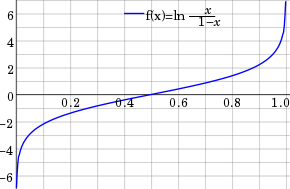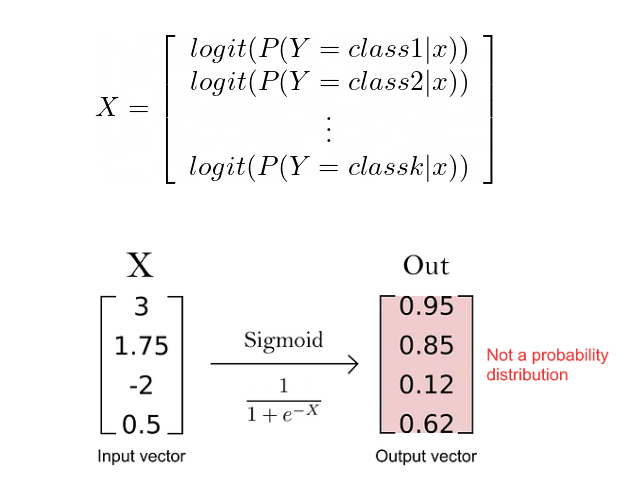Joonas' Note
logit vs. sigmoid vs. softmax 본문
Logit
logit 함수를 이해하려면 odds 를 알아야한다. logit 함수는 \( logit(p) = log(odds) \) 이기 때문이다.
Odds
odds 는 어떤 사건이 발생할 확률과 발생하지 않을 확률을 비교한 값이다. 일반적으로는 성공 확률을 실패 확률로 나누어서 계산한다고 한다.
$$ odds = \frac{p}{1-p} $$
여기에 로그를 씌운 함수를 logit function 이라고 부른다.
$$ logit(p) = log(odds) = log(\frac{p}{1-p}) $$
이 logit function 을 x=[0, 1] 에 대해서 그래프를 그려보면 아래와 같이 생겼다.

Sigmoid
sigmoid 함수는 logit function의 역함수이다. 즉, x와 y를 뒤집은 그래프라는 것이다.
$$ sigmoid(x) = \frac{1}{1+e^{-x}} $$
역함수임을 보이기 위해 logit function 으로부터 유도해보자면 아래와 같다.
logit function의 결과물(치역)을 \( X \) 로 놓고 역함수를 유도한다.
$$ logit(p) = log(\frac{p}{1-p}) = X $$
식을 전개해보면 다음과 같이 \(X\)에 대한 식을 구할 수 있다.
$$ \begin{align} X &= log(\frac{p}{1-p}) \\ e^{X} &= \frac{p}{1-p} \\ \frac{1}{e^X} &= \frac{1-p}{p} = \frac{1}{p} - 1 \\ \frac{1}{e^X} + 1 &= \frac{1}{p} \\ \frac{1+e^X}{e^X} &= \frac{1}{p} \\ p &= \frac{e^X}{1+e^X} = \frac{1}{1+e^{-X}} \end{align} $$
sigmoid 함수에 대한 설명은 많이 있는데, logit function 의 생김새를 떠올려보면 함수의 결과값이 [0, 1] 사이로 매핑되는 것을 직관적으로 이해할 수 있다.

그래프 설명에 Logistic 함수라고 적은 이유는, sigmoid 함수는 logistic 함수의 일부이기 때문이다.
요약하자면, sigmoid 함수는 logistic 함수에 제약을 건 부분 집합이라고 생각하면 된다.
자세한 설명은 아래의 링크를 참고하면 좋다.
What are the differences between Logistic Function and Sigmoid Function?
$$ \begin{equation} f(x)=\frac{L}{1+e^{-k(x-x_0)}} \end{equation} $$ Fig 1. (img) Logistic Function $$ \begin{equation} S(x)= \frac{1}{1+e^{-t}} \end{equation} $$ Fig 2. (img) Sigmoid Function What...
stats.stackexchange.com
그렇다면 당연하게도 \( sigmoid(logit(p(x))) = p(x) \) 라는 뜻이다.
Softmax
분류 문제에서 자주 사용되는 정규화 함수이다.
간단하게 정리하면 sigmoid 함수는 이진 분류(binary classfication)에 사용되고, 분류해야할 클래스가 2개 이상이라면 softmax를 사용한다.

위에서 알아본 바와 같이, sigmoid 함수는 어떤 사건이 발생할 확률과 그렇지 않을 확률을 계산한 odds 로부터 확장된 함수이기때문에 이진 분류에 사용된다.
sigmoid 와 동일한 방식으로, 여러 클래스를 벡터로 보고 계산하면 아래와 같이 된다.

사건 발생 확률의 전체 합이 1.0 이 되지 않는다. 왜냐하면 \(X\) 는 logit function을 통과한 값이고, 그렇다면 output은 분명 아래와 같다.
$$ e^X = e^{log(odds)} = odds $$
output vector의 각 element가 odds 그대로인 상황이다.
그래서 사용되는 것이 softmax 함수이고, 다음과 같이 생겼다.
$$ softmax(x) = \frac{ e^{x_i} } { \sum_{j=1}{K} e^{x_j} } $$
이제 softmax 를 통과한 input vector는 전체 확률의 합이 1.0 으로 계산된다.

Reference
Sigmoid and SoftMax Functions in 5 minutes
The math behind two of the most used activation functions in Machine Learning
towardsdatascience.com
Sigmoid function - Wikipedia
From Wikipedia, the free encyclopedia Mathematical function having a characteristic "S"-shaped curve or sigmoid curve A sigmoid function is a mathematical function having a characteristic "S"-shaped curve or sigmoid curve. A common example of a sigmoid fun
en.wikipedia.org
Logit - Wikipedia
From Wikipedia, the free encyclopedia Function in statistics This article is about the binary logit function. For other types of logit, see discrete choice. For the basic regression technique that uses the logit function, see logistic regression. For stand
en.wikipedia.org
What does Logits in machine learning mean?
"One common mistake that I would make is adding a non-linearity to my logits output." What does the term "logit" means here or what does it represent ?
datascience.stackexchange.com
Softmax function - Wikipedia
From Wikipedia, the free encyclopedia Smooth approximation of one-hot arg max This article is about the smooth approximation of one-hot arg max. For the smooth approximation of max, see LogSumExp. "Softmax" redirects here. For the Korean video game company
en.wikipedia.org
'AI' 카테고리의 다른 글
| [강화학습 메모] Proximal Policy Optimization (PPO, 2017) (0) | 2023.03.11 |
|---|---|
| [강화학습 메모] A3C (Asynchronous A2C, 2016) (0) | 2023.03.10 |
| [강화학습 일지] DQN Tutorial 살펴보기 (0) | 2023.01.13 |
| Loss 또는 모델 output이 NaN인 경우 확인해볼 것 (0) | 2022.04.23 |
| [부동산 가격 예측] LightGBM에서 DNN Regression으로 (0) | 2022.04.21 |



